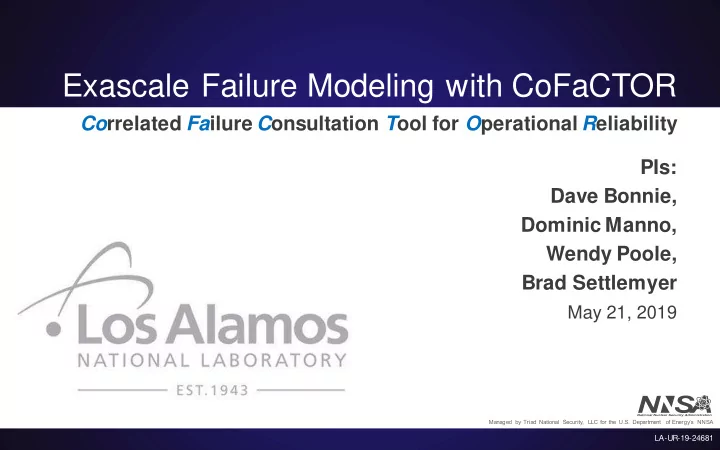

Exascale Failure Modeling with CoFaCTOR Co rrelated Fa ilure C onsultation T ool for O perational R eliability PIs: Dave Bonnie, Dominic Manno, Wendy Poole, Brad Settlemyer May 21, 2019 Managed by Triad National Security, LLC for the U.S. Department of Energy’s NNSA LA-UR-19-24681
BLUF (Bottom line up front) • We need a tool for Decision Support – Why? • We need to be able to do predictive analytics for system failures as well as potential catastrophic disk or filesystem failures. • Within the Exascale environment, the filesystems and network will be so complex determining failure causes without the assistance of a tool will be nearly impossible • We don’t believe the failures within the storage environment have been well-identified – Traditional assumptions on drive mix and failures no longer hold – multi- factor positional considerations (shelf position, rack, row) (vibration…) • LANL’s filesystem environment are very different from the cloud env. – A loss of 1MB stripe may invalidate the entire 1PB file • We save memory state, not cat pictures and memes Los Alamos National Laboratory 5/21/2019 | 2
Problem: Correlated disk failures Los Alamos National Laboratory 5/21/2019 | 3
Problem: Why is LANL hitting this now? • Large differences between hyperscalers and LANL – 98.3% of Youtube videos are less than 25MB* • LANL has very large files, tens of TB is not uncommon – Data loss event from failure is orders of magnitude different * “ Statistics and Social Network of Youtube Videos ”, Cheng, Dale, Liu Los Alamos National Laboratory 5/21/2019 | 4
Components Available Today • Data already collected – LANL File distributions – LANL Failure events – Industry failure events also published (e.g. BackBLAZE) • Industry standard data protection schemes – Parity-based data protection (GridRAID, ISA-L, RAIDZ3) • Existing Statistical Techniques appropriate – Monte Carlo simulation – Failure modes well studied for disks • Existing simulation toolkits are sufficient – PySIM , LANL’s Simian, OmNet++ Los Alamos National Laboratory 5/21/2019 | 5
Components Available Today • Data already collected – LANL File distributions – LANL Failure events These techniques are well understood in – Industry failure events also published (e.g. BackBLAZE) • Industry standard data protection schemes OR, statistics, reliability community. – Parity-based data protection (GridRAID, ISA-L, RAIDZ3) • Existing Statistical Techniques appropriate We simply need to apply them correctly to – Monte Carlo simulation – Failure modes well studied for disks our data! • Existing simulation toolkits are sufficient – PySIM , LANL’s Simian, OmNet++ Los Alamos National Laboratory 5/21/2019 | 6
CoFaCTOR Overview • Model inputs: LANL’s empirical file distribution o o Storage system characteristics o Protection strategies o Do we need more error protection and at what levels/complexity? • Evaluate failures via Monte Carlo o Generate realistic failure traces o Identify probabilities of loss o Analyze data loss scenarios o Evaluate and analyze distributions of effected files Los Alamos National Laboratory 5/21/2019 | 7
CoFaCTOR Usage • Using existing methods will enable: – Understanding catastrophic data loss scenarios • LANL HPC field’s approximately 11 different file systems – each with different data protection schemes and data retention times – Evaluating new technologies (with respect to data protection capabilities) – Improving future storage procurements • Additional opportunities: – Provide further collaboration for environments with similar predictive requirements (anyone here want to share?) :) – Provide further collaboration in this space across other federal agencies - DOD Los Alamos National Laboratory 5/21/2019 | 8
Recommend
More recommend